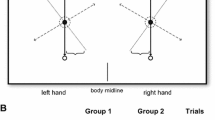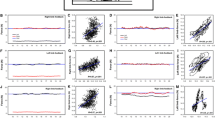Abstract.
Subjects performed a bimanual circle-tracing task in time with an auditory metronome while restricted to moving with either proximal or distal musculature of the upper limb. Patterns were made in symmetric or asymmetric directions with respect to the midline. Symmetric patterns were more stable than asymmetric patterns. In response to a visual stimulus, subjects reversed the direction of one limb. Unwanted disruptions (momentary or lasting reversals) in the limb contralateral to the reversing limb were observed in 48% of trials. Incidence of disruption was equivalent between postures, but occurred more frequently when the dominant hand reversed direction. This result is consistent with anisotropy in coupling between hands and reveals a unifying constraint between spontaneous and intentional dynamics in bimanual coordination.
Similar content being viewed by others
Author information
Authors and Affiliations
Additional information
Electronic Publication
Rights and permissions
About this article
Cite this article
Byblow, W., Lewis, G., Stinear, J. et al. The subdominant hand increases the efficacy of voluntary alterations in bimanual coordination. Exp Brain Res 131, 366–374 (2000). https://doi.org/10.1007/s002219900271
Received:
Accepted:
Issue Date:
DOI: https://doi.org/10.1007/s002219900271




